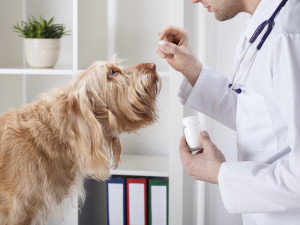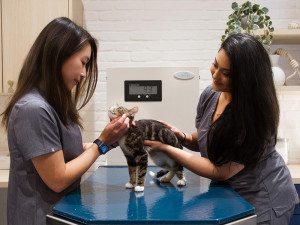What’s The Difference Between Spay and Neuter?
They’re both procedures that prevent your pet from reproducing.
In This Article:
Spay vs. Neuter What Is Neutering? What Is Spaying? Spay vs. Neuter Costs Spay vs. Neuter Aftercare
Over the years as a veterinarian, I have had to explain the difference between spaying and neutering many times. The terms are often used interchangeably, but spaying refers to the procedure performed on a female to prevent reproduction, while neutering refers to the procedure performed on a male. Neutering is also called castration.
I have also had many discussions with pet parents about whether they should spay or neuter their pets. Both of these surgeries have benefits other than preventing unwanted litters. This article will cover the benefits of both spaying and neutering cats and dogs, as well as compare the differences in procedures, recovery, cost, and aftercare recommendations.
Spay vs. neuter
Spaying and neutering are surgical procedures performed on cats and dogs by veterinarians to prevent them from reproducing. Neutering is for males and involves the removal of the testicles; spaying is for females and involves the removal of the uterus and ovaries.
How much do you spend on your pet per year?
Both are safe, routine procedures with good success rates when performed by a qualified veterinarian. What’s more, spaying and neutering are not only effective ways to prevent overpopulation but also provide real health and behavioral benefits for your pet.
What is neutering?
Whether you call it neutering or castration, the procedure is the same; the male animal’s testicles are removed surgically. This process is typically performed on cats and dogs, most often after they reach sexual maturity, although the timing can vary.
What happens during the procedure?
A dog or cat must be under general anesthesia to undergo neutering. In a dog, the veterinarian makes a small incision at the base of the penis and removes both testicles and then closes the incision with sutures or surgical glue.
In a cat, the incision is made over the scrotum, and the testicles are removed one at a time through each side of the scrotum. The surgery, in either case, is relatively quick, usually under 30 minutes, and recovery tends to be straightforward in most healthy animals.
Benefits of neutering
Neutering provides numerous advantages for both the pet and the pet parent
It helps with the problem of pet overpopulation by preventing reproduction.
Intact males can exhibit aggressive behavior and a tendency to roam, engaging in territorial marking. Neutering can decrease these behaviors.
From a health standpoint, neutering decreases the risk of testicular cancer and prostate issues.
Neutering may decrease dominance-related behaviors such as mounting, an action generally distasteful to pet parents.
If you do not plan on breeding your pet, neutering is a responsible choice due to these benefits.
When should you neuter?
The timing of neutering depends on the species, size, and breed:
Cats: Usually neutered around four to six months of age.
Small to medium dogs: Frequently neutered between six to 12 months.
Large breed dogs: Waiting until 12 to 18 months may be beneficial as hormones play a role in growth plate development and joint health.
Always consult your veterinarian to determine the optimal timing for your specific pet.
What is spaying?
Spaying, or ovariohysterectomy, is the surgical removal of a female animal’s ovaries and uterus and is performed under general anesthesia. It’s most common in cats and dogs but is also used in other species.
What happens during the procedure?
What happens when a cat is spayed? The veterinarian makes an incision in the abdomen, locates the ovaries and uterus, and removes them. The surgical site is then sutured closed in layers. This is a more invasive surgery than neutering and takes longer, often from 45 minutes to an hour depending on the animal’s size and condition.
Benefits of spaying
There are some important benefits of having your female pet spayed.
Unwanted pregnancies won’t occur if your pet is spayed.
Your dog or cat won’t have heat cycles if they are spayed.
Spaying reduces the risk of ovarian and uterine cancers and pyometra, a life-threatening uterine infection.
Spaying may also prevent mammary cancer, especially if done before the first heat cycle.
When should you spay?
Recommended spay timing varies:
Cats: Usually spayed around four to six months of age.
Dogs under 45 pounds: Often spayed between six to nine months.
Larger dogs: May benefit from delaying spaying until after the first heat (around 12 to 18 months), as this can help prevent orthopedic issues and certain types of cancer.
Your vet will assess your pet’s breed, health, and risk factors to make an individualized recommendation.
Spay vs. neuter costs
The cost of spaying or neutering can depend on several factors, including animal size, type of veterinary clinic, and whether any complications arise. Here’s a sample breakdown:
Average neutering costs
Cats: $50 to $150
Dogs: $75 to $250
Neutering is generally less expensive than spaying because it is a simpler and faster procedure.
Average spaying costs
Cats: $100 to $300
Dogs: $150 to $500
Spaying is more costly due to the complexity and time required. Large-breed dogs and animals in heat or pregnancy may cost more due to increased surgical time and monitoring needs.
Low-cost clinics and assistance
Many communities offer affordable or subsidized spay/neuter services through:
Nonprofit organizations
Municipal animal shelters
Mobile clinics
Veterinary schools
These programs are designed to help all pet parents afford these procedures regardless of their financial situation. You can often find these services through local animal control, rescue groups, or humane societies.
Additional costs to consider
Depending on age, behavior, and possible complications, some animals may require extra care which can add additional costs, such as:
Bloodwork prior to anesthesia
Pain medications for post-op recovery
E-collars to prevent licking the incision
Follow-up exams or emergency visits if complications occur
Ask your vet for a detailed cost estimate beforehand.
Spay vs. neuter aftercare
Both surgeries need to be monitored afterward. While neutering is not as complicated, you still need to keep a close eye on your male pet.
Immediate postoperative care
Quiet rest: Yes, that can be difficult for some pets, especially the younger ones and ones that are feeling the best. However, it’s important to keep your pet in a calm, confined area for at least seven days.
Elizabethan collar (cone): Licking the incision is a very common problem with animals. Use a cone or recovery collar to prevent licking or chewing.
Pain medication: Your pet may be sent home with pain medication or other meds. Give prescribed medications as directed; never give human pain relievers.
Limit activity: Avoid running, jumping, or rough play during the healing period.
Monitoring the incision site
Check the surgical site daily or even more often for:
Redness or swelling
Discharge or bleeding
Unusual odor
Opening of stitches
If you notice any of these signs or your pet seems excessively lethargic or uninterested in food, call your veterinarian.
Bathing and grooming
Do not bathe your pet or allow the incision to get wet for at least 10 to 14 days post-surgery. Moisture is your enemy. It can lead to infection or slow down the healing process.
Behavioral changes
Your pet may exhibit some changes in behavior following the surgery. Neutered males may show reduced marking or less aggressive behaviors within weeks. Spayed females will no longer go into heat, which can reduce howling, pacing, and mood swings.
However, surgery is not a quick fix for deeply rooted behavioral issues. Your pet may still have undesirable behaviors after surgery. Give it a little time, talk to your vet, and continue training.
Long-term health monitoring
Spayed and neutered pets often live longer, healthier lives. But keep in mind:
After spaying or neutering, your cat or dog may start to put on excess weight. Adjust the amount of food you feed and encourage exercise.
Annual checkups remain vital for the early detection of any health issues.
References
“Five Good Reasons Why You Should Spay or Neuter Your Pet.” Brown.edu, 2019, https://www.brown.edu/Research/Colwill_Lab/CBP/spaynueter.htmopens in new tab
“Spaying and Neutering Dogs Can Help Them Live Longer.” Uab.edu, 2019, https://www.uab.edu/news/news-you-can-use/spaying-and-neutering-dogs-can-help-them-live-longeropens in new tab
Young, Amy. “Spaying or Neutering Your Dog | Animal Health Topics / School of Veterinary Medicine.” 6 Dec. 2019, https://healthtopics.vetmed.ucdavis.edu/health-topics/canine/spaying-or-neutering-your-dogopens in new tab











